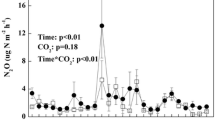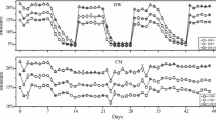Abstract
Fluctuations in soil water content, either anthropogenic or natural, can remarkably influence the C and N pools in arable lands. The dynamics of C and N are directly related in regulation of greenhouse gases (GHGs) emissions. The present study was conducted to explore the effects of water regimes (continuous flooding, continuous wet, and flooding converted to wet) on soil GHGs emissions. Nitrous oxide (N2O) emissions from continuous flooding treatment were lower as compared with the continuous wet soil, but significantly (p ≤ 0.01) enlarged in the flooding converted to wet soil treatment through increased mineral nitrogen. Methane (CH4) emissions were significantly (p ≤ 0.01) higher in the continuous flooding when compared with the wet soil conditions but substantially decreased in the flooding converted to wet soil treatment. Carbon dioxide (CO2) emissions were significantly (p ≤ 0.01) larger in the flooding converted to wet soil treatment as compared with the continuous flooding and wet soil treatments owing to increased mineralization and C contents. The results suggest that converting flooding to wet soil can substantially triggers the C and N pools and thus influences the GHGs emissions from soil.











Similar content being viewed by others
References
Akiyama H, Yagi K, Yan X (2005) Direct N2O emissions from rice paddy fields: summary of available data. Glob Biogeochem Cycles 19(1):23–30
Bakken LR, Frostegård Å (2012) Regulation of denitrification at the cellular level: a clue to the understanding of N2O emissions from soils. Philos Trans R Soc B 367(1593):1226–1234
Bodelier PLE, Laanbroek HJ (2004) Nitrogen as a regulatory factor of methane oxidation in soils and sediments. FEMS Microbiol Ecol 47(3):265–277
Bodelier PL, Roslev P, Henckel T, Frenzel P (2000) Stimulation by ammonium-based fertilizers of methane oxidation in soil around rice roots. Nature 403(6768):421–424
Bollmann A (2010) Influence of O2 availability on NO and N2O release by nitrification and denitrification in soils. Glob Chang Biol 4(4):387–396
Breidenbach B, Blaser MB, Klose M, Conrad R (2016) Crop rotation of flooded rice with upland maize impacts the resident and active methanogenic microbial community. Environ Microbiol 18(9):2868–2885
Butterbach-Bahl K, Papen H (2002) Four years continuous record of CH4-exchange between the atmosphere and untreated and limed soil of a N-saturated spruce and beech forest ecosystem in Germany. Plant Soil 240(1):77–90
Butterbach-Bahl K, Baggs EM, Dannenmann M, Kiese R, Zechmeister-Boltenstern S (2013) Nitrous oxide emissions from soils: how well do we understand the processes and their controls? Philos Trans R Soc Lond Ser B Biol Sci 368(1621):20130122
Buysse, P, Flechard, CR, Hamon, Y, Viaud, V (2016) Impacts of water regime and land-use on soil CO2 efflux in a small temperate agricultural catchment. Biogeochemistry 130(3):267–288
Chen Z, Ding W, Luo Y, Yu H, Xu Y, Müller C, Xu X, Zhu T (2015) Nitrous oxide emissions from cultivated black soil: a case study in Northeast China and global estimates using empirical model. Glob Biogeochem Cycles 28(11):1311–1326
Dalal RC, Wang W, Robertson GP, Parton WJ (2003) Nitrous oxide emission from Australian agricultural lands and mitigation options: a review. Soil Res 41(2):165–195
Dalal RC, Allen DE, Livesley SJ, Richards G (2008) Magnitude and biophysical regulators of methane emission and consumption in the Australian agricultural, forest, and submerged landscapes: a review. Plant Soil 309(1/2):43–76
Dan J, Kruger M, Frenzel P, Conrad R (2001) Effect of a late season urea fertilization on methane emission from a rice field in Italy. Agric Ecosyst Environ 83(1):191–199
Davidson EA, Trumbore SE, Amundson R (2000) Biogeochemistry - soil warming and organic content. Nature 440:165–173
Denef K, Six J, Bossuyt H, Frey SD, Elliott ET, Merckx R, Paustian K (2001) Influence of dry–wet cycles on the interrelationship between aggregate, particulate organic matter, and microbial community dynamics. Soil Biol Biochem 33(12–13):1599–1611
Groffman PM, Crawford MK (2003) Denitrification potential in urban riparian zones. J Environ Qual 32(3):1144
Harrison-Kirk T, Thomas SM, Clough TJ, Beare MH, Weerden TJVD, Meenken ED (2015) Compaction influences N2O and N2 emissions from 15 N-labeled synthetic urine in wet soils during successive saturation/drainage cycles. Soil Biol Biochem 88:178–188
Hiltbrunner D, Zimmermann S, Karbin S, Hagedorn F, Niklaus PA (2012) Increasing soil methane sink along a 120-year afforestation chronosequence is driven by soil moisture. Glob Chang Biol 18(12):3664–3671
Huang TQ, Ma YC, Xiong ZQ, Kong XW, Yu FY (2010) CH4 and N2O emissions from paddy field during the upland crop growing season in relation to cropping pattern. J Ecol Rural Environ 26(6):519–523
Kader MA, Sleutel S, Begum SA, Moslehuddin AZM, Neve SD (2013) Nitrogen mineralization in sub-tropical paddy soils in relation to soil mineralogy, management, pH, carbon, nitrogen and iron contents. Eur J Soil Sci 64(1):47–57
Kim DG, Vargas R, Bondlamberty B, Turetsky MR (2012) Effects of soil rewetting and thawing on soil gas fluxes: a review of current literature and suggestions for future research. Biogeosciences 9(7):2459–2483
Koebsch F, Glatzel S, Hofmann J, Forbrich I, Jurasinski G (2014) CO2 exchange of a temperate fen during the conversion from moderately rewetting to flooding. J Geophys Res Biogeosci 118(2):940–950
Lalande R, Gagnon B, Royer I (2009) Impact of natural or industrial liming materials on soil properties and microbial activity. Can J Soil Sci 89(2):209–222
Luo Y, Zhou X (2006) Soil respiration and the environment. Academic Press, London, p 328
Moore, BD, Kaur, G, Motavalli, PP, Zurweller, BA, Svoma, BM (2017) Soil greenhouse gas emissions from agroforestry and other land uses under different moisture regimes in lower Missouri River Floodplain soils: a laboratory approach. Agrofor Syst 92(2):335–348
Peng Q, Shaaban M, Hu R, Mo Y, Wu Y, Ullah B (2015) Effects of soluble organic carbon addition on CH4 and CO2 emissions from paddy soils regulated by iron reduction processes. Soil Res 53(3):316–324
Schimel J (2000) Global change: rice, microbes and methane. Nature 403(6768):375–377
Shaaban M, Abid M, Peng QA (2013) Short term influence of gypsum, farm manure and commercial humic acid on physical properties of salt affected soil in Rice Paddy system. J Chem Soc Pak 35(3):1034–1040
Shaaban M, Peng Q, Hu R, Lin S, Zhao J (2016a) Soil nitrous oxide and carbon dioxide emissions following incorporation of above- and below-ground biomass of green bean. Int J Environ Sci Technol 13(1):179–186
Shaaban M, Peng QA, Lin S, Wu Y, Khalid MS, Wu L, Mo Y, Hu R (2016b) Dolomite application enhances CH4 uptake in an acidic soil. Catena 140:9–14
Shaaban M, Wu Y, Khalid MS, Peng QA, Xu X, Wu L, Younas A, Bashir S, Mo Y, Lin S (2018) Reduction in soil N2O emissions by pH manipulation and enhanced nosZ gene transcription under different water regimes. Environ Pollut 235:625–631
Shang Q, Yang X, Gao C, Wu P, Liu J, Xu Y, Shen Q, Zou J, Guo S (2011) Net annual global warming potential and greenhouse gas intensity in Chinese double rice-cropping systems: a 3-year field measurement in long-term fertilizer experiments. Glob Chang Biol 17(6):2196–2210
Singh SK, Sidhu GS, Choudhury SG, Pandey CB, Banerjee T, Sarkar D (2014) Soil organic carbon density in arable and non-arable lands under varied soil moisture and temperature regimes in cold arid to sub-tropical areas of Western Himalaya, India. Arid Soil Res Rehab 28(2):169–185
Sitaula BK, Bakken LR, Abrahamsen G (1995) CH4 uptake by temperate forest soil: effect of N input and soil acidification. Soil Biol Biochem 27(7):871–880
Soil-Survey-Staff (2010) Keys to soil taxonomy, 11th edn. USDA Natural Resources Conservation Service, Washington, DC
Stocker T, Qin D, Plattner G, Tignor M, Allen S, Boschung J, Nauels A, Xia Y, Bex V, Midgley P IPCC (2013) 2013: climate change 2013: the physical science basis. Contribution of working group i to the fifth assessment report of the intergovernmental panel on climate change, of the intergovernmental panel on climate change. Available
Wang W, Dalal RC, Reeves SH, Butterbach-Bahl K, Kiese R (2011) Greenhouse gas fluxes from an Australian subtropical cropland under long-term contrasting management regimes. Glob Chang Biol 17(10):3089–3101
Wang H, Guan D, Zhang R, Chen Y, Hu Y, Xiao L (2014) Soil aggregates and organic carbon affected by the land use change from rice paddy to vegetable field. Ecol Eng 70(70):206–211
Weller S, Janz B, Jörg L, Kraus D, Racela HS, Wassmann R, Butterbachbahl K, Kiese R (2016) Greenhouse gas emissions and global warming potential of traditional and diversified tropical rice rotation systems. Glob Chang Biol 22(1):432–448
Wu L, Tang S, He D, Wu X, Shaaban M, Wang M, Zhao J, Khan I, Zheng X, Hu R (2017) Conversion from rice to vegetable production increases N2O emission via increased soil organic matter mineralization. Sci Total Environ 583:190–201
Yang H, Sheng R, Zhang Z, Wang L, Wang Q, Wei W (2016) Responses of nitrifying and denitrifying bacteria to flooding-drying cycles in flooded rice soil. Appl Soil Ecol 103:101–109
Yuan Y, Dai X, Wang H, Xu M, Fu X, Yang F (2015) Effects of land-use conversion from double rice cropping to vegetables on methane and nitrous oxide fluxes in southern China. Ying Yong Sheng Tai Xue Bao 11(5):147–154
Zhang X, Kong JY, Xia FF, Su Y, He R (2014) Effects of ammonium on the activity and community of methanotrophs in landfill biocover soils. Syst Appl Microbiol 37(4):296–304
Zheng Y, Zhang LM, He JZ (2013) Immediate effects of nitrogen, phosphorus, and potassium amendments on the methanotrophic activity and abundance in a Chinese paddy soil under short-term incubation experiment. J Soils Sed 13(1):189–196
Funding
This work was financially supported by China Postdoctoral Science Foundation (2017M622478) and National Science Foundation of China (No. 41750110485).
Author information
Authors and Affiliations
Corresponding authors
Ethics declarations
Conflict of Interest
The authors declare that they have no conflict of interest.
Additional information
Publisher’s Note
Springer Nature remains neutral with regard to jurisdictional claims in published maps and institutional affiliations.
Rights and permissions
About this article
Cite this article
Khalid, M.S., Shaaban, M. & Hu, R. N2O, CH4, and CO2 Emissions from Continuous Flooded, Wet, and Flooded Converted to Wet Soils. J Soil Sci Plant Nutr 19, 342–351 (2019). https://doi.org/10.1007/s42729-019-00034-x
Received:
Accepted:
Published:
Issue Date:
DOI: https://doi.org/10.1007/s42729-019-00034-x




